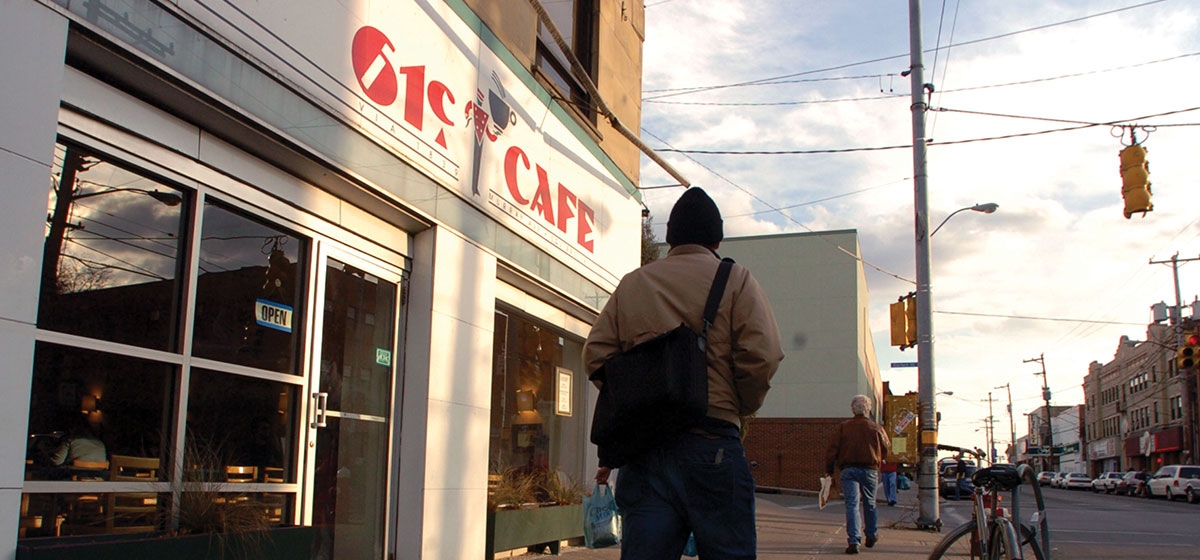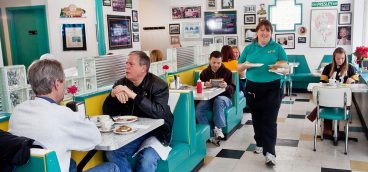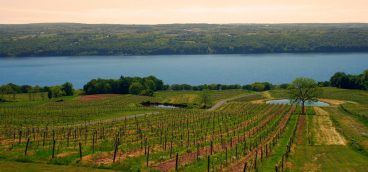
“Jews are just like everybody else, only more so,” Wyoming Benjamin Paris* liked to say. He was an authority on the subject of chutzpah, and the star of his Hill District basketball team — a team with no uniforms or name.
In 1919, the year of his bar mitzvah, he hopped a streetcar from Downtown to the wooded suburb of Squirrel Hill in search of Mrs. Enoch Rauh, whose husband had just died. Would she buy them uniforms if they called their team “The Enoch Rauh Club”?
She would. They did. The team became a local legend — a seminal case of sports naming-rights and Squirrel Hill philanthropy. Enoch Rauh was a beloved figure, the first Jewish member of Pittsburgh City Council. Seventy years later, Squirrel Hill’s Sophie Masloff would become the city’s first Jewish (and female) mayor, equally beloved.
More on them later.
Pittsburgh’s most famous ethnic neighborhood, just east of Downtown, is a throbbing place where two dozen synagogues, temples, yeshivas and kosher delis bump elbows with upscale boutiques, old-fashioned markets that (incredibly) still deliver, and two of the last first-run movie houses left in the city limits.
The big influx of Jews dates from the early 1920s, when once-poor Eastern European immigrants began to move there from Oakland and the Hill District in increasingly affluent numbers. Since then, “The stability of Squirrel Hill as a geographic hub of the Jewish community within city limits is unique in North America,” according to the United Jewish Federation.
But contrary to popular belief and colorful appearance, Squirrel Hill wasn’t—and isn’t—“all Jewish, all the time.” Only about a quarter of its 26,000 current residents are Judaic. All manner of WASPS and other racial and ethnic groups occupy the humble homes, palatial mansions and high-rise apartments that spread out from its hub at Forbes and Murray avenues.
“Depending on your mood, Squirrel Hill offers a diversity you can get lost in—or find your personal niche in,” says Pittsburgh native-entrepreneur Allison Drash.
Indeed, it’s a fabulous place simply to wander about.
“As teenagers growing up in the East End,” Drash recalls, “my friends and I would always go ‘up street’—meaning Squirrel Hill—and spend hours just hanging out at ‘the Benches.’ I still love people-watching at that infamous meeting place. The tiny corner park there, next to the Post Office at Murray and Darlington, is still the hangout-of-choice for skaters, slackers, hippie kids and old folks. It’s one of the traditions Squirrel Hill is built on.”
Jews and non-Jews alike are but latecomers there. Before the 18th-century intrusion of Europeans, it was a wilderness and Native American hunting ground in which humans were vastly outnumbered by an astonishing number of noisy gray squirrels. Hence—as they say—the name. The main attraction to white pioneer farmers and Indian traders in the 1760s was its abundant game, free land and proximity to the protection of Fort Pitt (née Duquesne).
Squirrel Hill’s genesis as an outlying village to Pittsburgh began along the Monongahela—its riverfront connection to the fort and the outside world, according to Franklin Toker’s definitive “Pittsburgh, an Urban Portrait.” The area’s first recorded house was built in 1760 by British Col. James Burd at a spot on the Mon called Summerset, not far from its first “business district” at what’s now the intersection of Brown’s Hill Road and Beechwood Boulevard.
One of Squirrel Hill’s first settlers was Mary Girty Turner, who came in search of a son abducted by Indians. In 1769, when the colonial government opened an office for the sale of land in western Pennsylvania, Turner’s sons George and Simon were among the first to apply for property. Simon soon became a renegade leader of the Mingoe Indians, who fought on the losing side of the British Redcoats during the American Revolution.
By 1820, the little settlement could boast what every little settlement needed: a tavern with an inn for overnight travelers, built by a man named William “Killymoon” Stewart at the big bend of Beechwood (surviving there until World War II). By the middle of that century, Squirrel Hill had turned into a prosperous hamlet benefiting from the “Millionaire’s Row” along Fifth Avenue that extended to and beyond Shady Avenue after the Civil War, when Pittsburgh’s industrial elite built castles for themselves on the 50 forested acres between Fifth and Wilkins avenues.
Squirrel Hill was officially annexed to the city in 1868, but its pastoral essence was retained and protected by two monumental gifts of the pristine forests, bracketing its east and west sides, that became Pittsburgh’s greatest parks. The western one was donated by Mary Elizabeth Croghan, granddaughter-heiress of Pittsburgh pioneer James O’Hara. In 1842 at age 16, Mary went AWOL from her boarding school to elope with 43-year-old Capt. Edward Schenley of the British army. It was infamous Ed’s third elopement and inspired much public outrage, prompting the U.S. government to send its Coast Guard after the lovebirds-on-the-lam, who fled to England. Half a century later in 1889, when all was forgiven, Mary Schenley returned to the hometown she always said she loved and proved it by giving the glorious 420-acre tract that bears her name.
When Squirrel Hill originally materialized, it looked onto the Monongahela River, but that southern orientation became obsolete as its north end expanded to merge with Oakland and Shadyside. The community gradually did an about-face, historian Toker observes, especially after 1893 when construction of hundreds of new homes for steel company middle management was spurred by the installation of an electric trolley that ran up Forbes Avenue to Schenley Park and down Murray to Homestead. (Despite the trolley, Murray was a dirt road until 1920!)
Pittsburgh’s second fine park came from coal-and-steel baron Henry Clay Frick, Andrew Carnegie’s right-hand, iron-fisted man. When he died in 1919, Frick gave 150 beautiful acres on Squirrel Hill’s east border to the city. Frick Park opened in 1927 with a $2 million trust fund used to maintain and later enlarge it to 600 acres—much of it in nearly primeval condition.
Squirrel Hill’s population jumped further in the mid-1920s with the creation of the Boulevard of the Allies. It was a state-of-the-art connection to Downtown, increasing the movement of Eastern European Jews from Oakland and the Hill District to Squirrel Hill. In 1943, the Jewish community’s Irene Kaufmann Settlement likewise abandoned the old Hill for Squirrel Hill. In its wake has come the Jewish Community Center, descended from a merger with the Young Men’s Hebrew Association, whose superb facilities at Forbes and Murray nowadays serve as a focal point of the progressive community’s life, education and recreation.
The Rauhs would be proud. Talk about progressive. Enoch worked tirelessly to get local anti-child-labor and workmen’s sick-leave and injury-compensation laws enacted. Bertha (“the Jane Addams of Pittsburgh”) was a suffragist and music-and-arts patroness who founded free dental clinics, “penny lunches” for poor children, and programs for Jewish-Gentile cultural understanding.
Sophie Masloff is proud. Born to Romanian parents, she spoke only Yiddish until she entered public elementary school here. She started work as a civil servant in local government at 18 and stayed there until elected to Pittsburgh city council in 1976. She worked her way up to council president, served out Mayor Richard Caliguiri’s term when he died in 1988 and was reelected in her own right in 1989. Among her accomplishments was to finally put street signs on every corner—the ultimate Pittsburgh achievement—before retiring to her Squirrel Hill home in 1994.
Jewish grandma Mayor Masloff, at 70, produced the following immortal Abbott and Costello-esque exchange during a 1988 council discussion about police security for big rock-group appearances:
Masloff: “There’s an upcoming concert by The How?”
Staffer: “Not the How, The Who.”
Masloff: “Who?”
Staffer: “The Who.”
Masloff: “Is there a Who group and a How group?”
Staffer: “There isn’t a group called The How as far as I know.”
You gotta love Sophie—still vibrant, unique and delightful. And you gotta love her Squirrel Hill for the same reasons.
* If you’ve made it to this paragraph, you deserve an amplification of the first one: Wyoming Benjamin Paris (1906-2001), my father, was the first Jewish boy born in the state of Wyoming, for which his Ukrainian immigrant parents named him. My mother always said she was glad he wasn’t born in Virginia.





